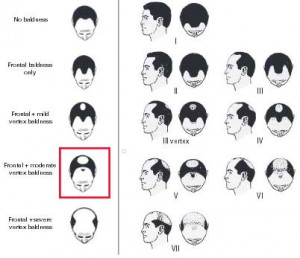April 7, 2020 by John Fernandez
Early Baldness at Middle Age May Be Linked to Prostate Cancer, Study Says

 Men who said they showed a certain degree of baldness at age 45 had a 39 percent higher risk of being diagnosed with an aggressive form of prostate cancer, compared with men with no hair loss or a lesser degree of baldness, according to a new U.S. study published Monday.
Men who said they showed a certain degree of baldness at age 45 had a 39 percent higher risk of being diagnosed with an aggressive form of prostate cancer, compared with men with no hair loss or a lesser degree of baldness, according to a new U.S. study published Monday.
Researchers say the findings create a potentially new link between the male hormone testosterone and the development of prostate cancer. The levels and behavior of testosterone in men drive both hair loss and prostate cancer.
But the authors of the study published in the Journal of Clinical Oncology also concede that middle-aged men with “male pattern baldness” should not be overly concerned. The study did not prove cause and effect between baldness and prostate cancer.
Many men at middle age begin to see signs of early male pattern baldness, which refers to a frontal hairline receding at the corners, combined with the thinning on the vertex, or crown of the head. The hair loss pattern associated with the higher risk of prostate cancer was “frontal baldness plus moderate vertex (crown) baldness” at age 45. (See fourth row in illustration above.)
The study creates the possibility that primary care physicians may intensify prostate screenings for men in their 40s if they show certain levels of male pattern baldness, said Mark Caruso, M.D., a primary care physician at Baptist Health Medical Group.
“This raises the question: Should we start looking a little earlier at these men (with early male pattern baldness) who may develop aggressive prostate cancer in their 50s,” Caruso said.
Nonetheless, men in their 40s, whether balding or not, should have annual checkups that include basic prostate exams, Caruso said.
The data that produced the study’s findings stemmed from the Prostate, Lung, Colorectal and Ovarian Cancer Screening Trial, a large project started in the early 1990s by the National Cancer Institute. The NCI study was launched to determine whether certain screening methods reduce cancer death rates.
As part of the NCI trial, from 2006 to 2008, researchers had men fill out questionnaires and asked them to select one of five illustrations that most closely matched their hair-loss patterns at the age of 45. The median age of the approximately 39,000 men who responded to the survey was about 70.
Researchers followed up after a median period of 2.8 years. About 1,140 cases of prostate cancer were diagnosed. About half of them were classified as aggressive.
About 53 percent of the total group of men noted some form of male pattern baldness at age 45. Overall, men who had any level of baldness patterns at 45 did not have a statistically significant higher risk of any form of prostate cancer later in life, compared men with no baldness.
However, men with “frontal plus moderate vertex balding” — or about 10 percent of the men in the study — had a 39 percent increased risk of aggressive prostate cancer, compared with men with no baldness.
Researchers labeled this a statistically significant finding, since it wasn’t likely due to chance.
Also read:
top stories












There are no comments